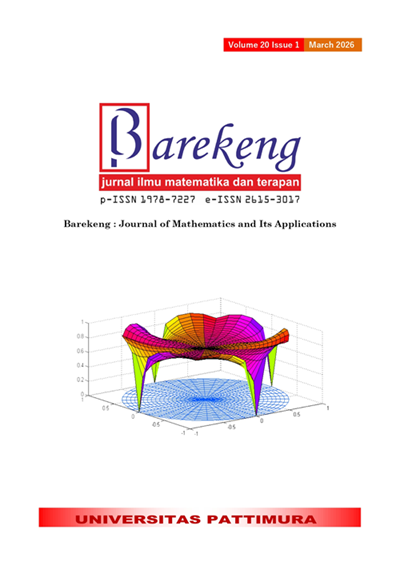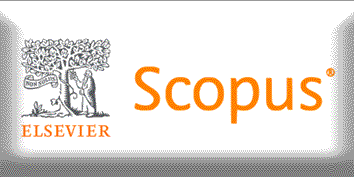FORECASTING INDONESIA COMPOSITE INDEX USING HYBRID AUTOREGRESSIVE INTEGRATED MOVING AVERAGE-DOUBLE RANDOM FOREST MODEL
Abstract
Modeling time series data using autoregressive integrated moving average (ARIMA) has been widely discussed. However, this has limitations in that it can only handle linear data. Machine learning is one of the alternative approaches that can solve this limitation since this method can handle nonlinear cases. Double random forest (DRF) is considered a supervised learning method that can solve regression problems. This research provides a novel hybrid forecasting framework combining ARIMA and DRF, designed to model both linear and nonlinear behaviors, and provide more accurate predictions for volatile financial data like the Indonesia Composite Index (ICI). Previous studies have not examined the performance of the hybrid ARIMA-DRF model. In this study, the performance of ARIMA, DRF, and the hybrid ARIMA-DRF models is compared using ICI data obtained from Bank Indonesia’s website. ICI has nonstationary and nonlinear characteristics. This made the ICI data suitable to be modeled using the hybrid ARIMA-DRF model. The comparison results indicate that the hybrid ARIMA-DRF model outperforms the independent ARIMA and DRF models, with a value of its mean absolute percentage error is 4.17%. Therefore, forecasting the future value of ICI data was done by using a hybrid ARIMA-DRF model with forecasting periods from October 2023 to September 2024. The forecasting results show that ICI values fluctuate over the forecasting periods, hence the authority might use the pattern to predict the ICI behaviors and take further decisions. While the forecasting results offer valuable insights for decision-making, this study has limitations as it does not incorporate external macroeconomic variables that may influence ICI behavior.
Downloads
References
J. D. Cryer and K. Chan, TIME SERIES ANALYSIS WITH APPLICATION IN R. NEW YORK: SPRINGER SCIENCE+BUSINESS MEDIA, LLC, 2008. doi: https://doi.org/10.1007/978-0-387-75959-3
D. Kobiela, D. Krefta, W. Król, and P. Weichbroth, “ARIMA VS LSTM ON NASDAQ STOCK EXCHANGE DATA,” Procedia Comput. Sci., vol. 207, pp. 3830–3839, 2022. doi: https://doi.org/10.1016/j.procs.2022.09.445
E. Dave, A. Leonardo, M. Jeanice, and N. Hanafiah, “FORECASTING INDONESIA EXPORTS USING A HYBRID MODEL ARIMA-LSTM,” Procedia Comput. Sci., vol. 179, pp. 480–487, 2021. doi: https://doi.org/10.1016/j.procs.2021.01.031
O. Fathi, “TIME SERIES FORECASTING USING A HYBRID ARIMA AND LSTM MODEL,” Velv. Consult., pp. 1–7, 2019.
F. Haselbeck, J. Killinger, K. Menrad, T. Hannus, and D. G. Grimm, “MACHINE LEARNING OUTPERFORMS CLASSICAL FORECASTING ON HORTICULTURAL SALES PREDICTIONS,” Mach. Learn. with Appl., vol. 7, 2022. doi: 10.1016/j.mlwa.2021.100239. doi: https://doi.org/10.1016/j.mlwa.2021.100239
S. Han, H. Kim, and Y. S. Lee, “DOUBLE RANDOM FOREST,” Mach. Learn., vol. 109, no. 8, pp. 1569–1586, 2020. doi: https://doi.org/10.1007/s10994-020-05889-1
A. P. Ratnasari, B. Susetyo, and K. A. Notodiputro, “COMPARISON OF DOUBLE RANDOM FOREST AND LONG SHORT-TERM MEMORY METHODS FOR ANALYZING ECONOMIC INDICATOR DATA,” BAREKENG J. Ilmu Mat. dan Terap., vol. 17, pp. 757–766, 2023. doi: https://doi.org/10.30598/barekengvol17iss2pp0757-0766
N. Prawoto and B. A. Putra, “THE FACTORS AFFECTING THE COMPOSITE STOCK PRICE INDEX ( CSPI ) OF INDONESIA STOCK EXCHANGE,” J. Ekon. dan Stud. Pembang., vol. 21, 2020. doi: 10.18196/jesp.21.1.5032. doi: https://doi.org/10.18196/jesp.21.1.5032
M. Kumar and M. Thenmozhi, “FORECASTING STOCK INDEX RETURNS USING ARIMA-SVM, ARIMA-ANN, AND ARIMA-RANDOM FOREST HYBRID MODELS,” Int. J. Banking, Account. Financ., vol. 5, no. 3, pp. 284–308, 2014. doi: https://doi.org/10.1504/IJBAAF.2014.064307
N. Merh, V. Prakash Saxena, and K. Raj Pardasani, “A COMPARISON BETWEEN HYBRID APPROACHES OF ANN AND ARIMA FOR INDIAN STOCK TREND FORECASTING,” Bus. Intell. J., pp. 23–43, 2010.
F. P. Pai and C. S. Lin, “A HYBRID ARIMA AND SUPPORT VECTOR MACHINES MODEL IN STOCK PRICE FORECASTING,” Int. J. Manag. Sci., vol. 33, pp. 497–505, 2005. doi: https://doi.org/10.1016/j.omega.2004.07.024
S. Ray, A. Lama, P. Mishra, T. Biswas, S. S. Das, and B. Gurung, “AN ARIMA-LSTM MODEL FOR PREDICTING VOLATILE AGRICULTURAL PRICE SERIES WITH RANDOM FOREST TECHNIQUE,” Appl. Soft Comput., vol. 149, 2023. doi: https://doi.org/10.1016/j.asoc.2023.110939
J. Zhang, H. Liu, W. Bai, and X. Li, “A HYBRID APPROACH OF WAVELET TRANSFORM, ARIMA, AND LSTM MODEL FOR THE SHARE PRICE INDEX FUTURES FORECASTING,” North Am. J. Econ. Financ., vol. 69, 2023. doi: https://doi.org/10.1016/j.najef.2023.102022
C. H. Chien, A. J. C. Trappey, and C. C. Wang, “ARIMA-ADABOOST HYBRID APPROACH FOR PRODUCT QUALITY PREDICTION IN ADVANCED TRANSFORMER MANUFACTURING,” Adv. Eng. Informatics, vol. 57, 2023. doi: https://doi.org/10.1016/j.aei.2023.102055
D. C. Montgomery, C. L. Jennings, and M. Kulahci, “INTRODUCTION TIME SERIES ANALYSIS AND FORECASTING,” P. 671, 2015.
T. T. H. PHAN AND X. H. NGUYEN, “COMBINING STATISTICAL MACHINE LEARNING MODELS WITH ARIMA FOR WATER LEVEL FORECASTING,” Adv. Water Resour., vol. 142, 2020. doi: https://doi.org/10.1016/j.advwatres.2020.103656
W. Zha et al., “FORECASTING MONTHLY GAS FIELD PRODUCTION BASED ON THE CNN-LSTM MODEL,” Energy, vol. 260, 2022. doi: https://doi.org/10.1016/j.energy.2022.124889
G. I. Drewil and R. J. Al-Bahadili, “AIR POLLUTION PREDICTION USING LSTM DEEP LEARNING AND METAHEURISTICS ALGORITHMS,” Meas. Sensors, vol. 24, 2022. doi: https://doi.org/10.1016/j.measen.2022.100546
I. Nasirtafreshi, “FORECASTING CRYPTOCURRENCY PRICES USING RECURRENT NEURAL NETWORK AND LONG SHORT-TERM MEMORY,” Data Knowl. Eng., vol. 139, no. October 2021, p. 102009, 2022. doi: https://doi.org/10.1016/j.datak.2022.102009
H. Prabowo, Suhartono, and D. D. Prastyo, “THE PERFORMANCE OF RAMSEY TEST, WHITE TEST, AND TERASVIRTA TEST IN DETECTING NONLINEARITY,” INFERENSI, vol. 3, no. 1, 2020. doi: https://doi.org/10.12962/j27213862.v3i1.6876
A. J. Wibowo and R. Khoirudin, “DOES MACROECONOMIC FLUCTUATION MATTER FOR THE COMPOSITE STOCK PRICE INDEX?,” J. Ekon. Pembang., vol. 20, no. 1, pp. 105–114, 2022. doi: https://doi.org/10.29259/jep.v20i1.17479
Copyright (c) 2025 Andika Putri Ratnasari, Luthfia Hanun Yuli Arini

This work is licensed under a Creative Commons Attribution-ShareAlike 4.0 International License.
Authors who publish with this Journal agree to the following terms:
- Author retain copyright and grant the journal right of first publication with the work simultaneously licensed under a creative commons attribution license that allow others to share the work within an acknowledgement of the work’s authorship and initial publication of this journal.
- Authors are able to enter into separate, additional contractual arrangement for the non-exclusive distribution of the journal’s published version of the work (e.g. acknowledgement of its initial publication in this journal).
- Authors are permitted and encouraged to post their work online (e.g. in institutional repositories or on their websites) prior to and during the submission process, as it can lead to productive exchanges, as well as earlier and greater citation of published works.






1.gif)



